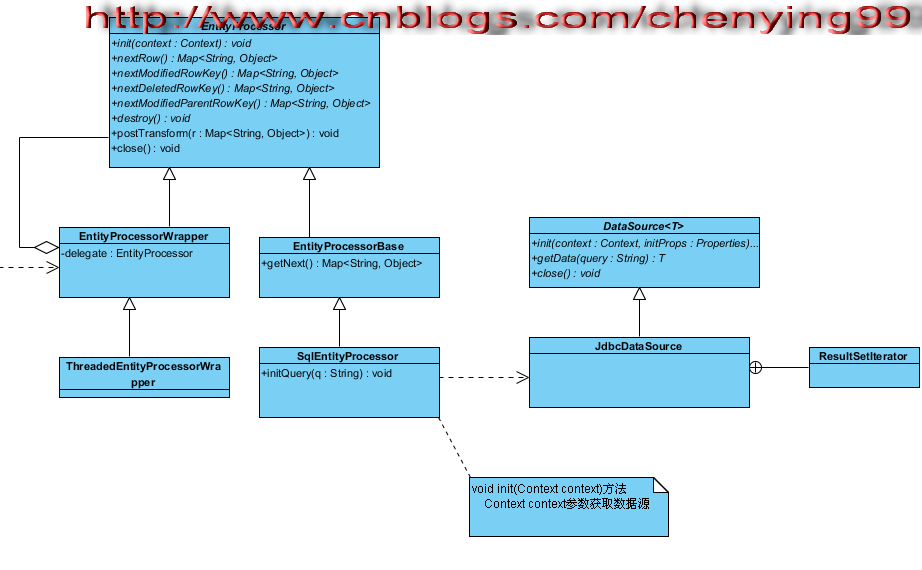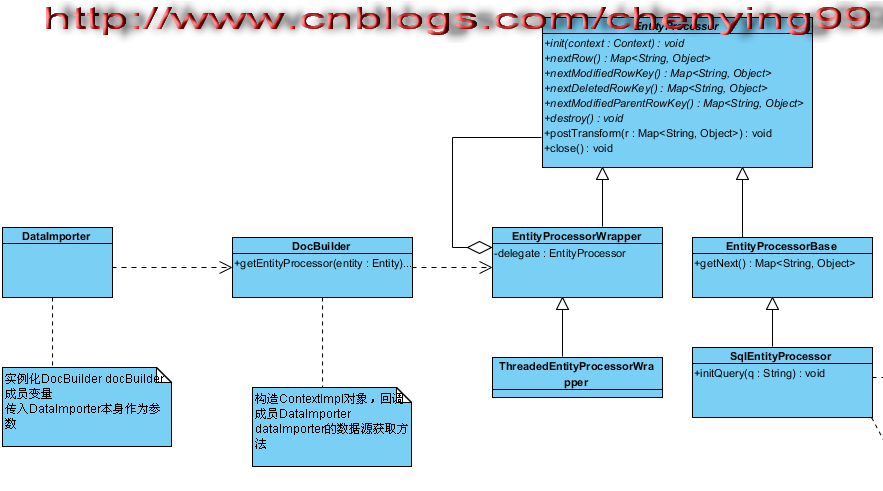去年本人写过一系列 solr dataimport 数据导入源码分析,由于博客园系统存在一些问题,后来上传的相同名称的图片覆盖了原来的图片,导致原来文章里面的图片与其内容不符合,我这里重新整理一下,也同时更新一些心得
solr dataimport 数据导入的全局UML类图如下(分两张,我的显示器不够大,显示器显示不完)


从上面的UML类图看以看出,这里面是采取了装饰模式以及迭代子模式等
我们首先来分析DataSource类,该类为抽象泛型类,定义了初始化数据源和获取泛型数据的方法
/** * <p> * Provides data from a source with a given query. * </p> * <p/> * <p> * Implementation of this abstract class must provide a default no-arg constructor * </p> * <p/> * <p> * Refer to <a * href="http://wiki.apache.org/solr/DataImportHandler">http://wiki.apache.org/solr/DataImportHandler</a> * for more details. * </p> * <p/> * <b>This API is experimental and may change in the future.</b> * * @version $Id: DataSource.java 684025 2008-08-08 17:50:11Z shalin $ * @since solr 1.3 */ public abstract class DataSource<T> { /** * Initializes the DataSource with the <code>Context</code> and * initialization properties. * <p/> * This is invoked by the <code>DataImporter</code> after creating an * instance of this class. * * @param context * @param initProps */ public abstract void init(Context context, Properties initProps); /** * Get records for the given query.The return type depends on the * implementation . * * @param query The query string. It can be a SQL for JdbcDataSource or a URL * for HttpDataSource or a file location for FileDataSource or a custom * format for your own custom DataSource. * @return Depends on the implementation. For instance JdbcDataSource returns * an Iterator<Map <String,Object>> */ public abstract T getData(String query); /** * Cleans up resources of this DataSource after use. */ public abstract void close(); }
该抽象类的注释很清楚,有不同的数据源继承类,包括针对数据库的JdbcDataSource数据源,针对URL的HttpDataSource数据源,针对本地文件的FileDataSource数据源,甚至还可以自定义数据源
我这里只分析数据库的JdbcDataSource数据源,其他数据源类似,比较容易理解了
针对数据库的JdbcDataSource数据源是获取Iterator<Map<String, Object>>数据迭代器
//数据库连接工厂 protected Callable<Connection> factory; private long connLastUsed = 0; //当前数据库连接 private Connection conn; //字段名与类型的映射 private Map<String, Integer> fieldNameVsType = new HashMap<String, Integer>(); //是否转换类型 private boolean convertType = false; private int batchSize = FETCH_SIZE; private int maxRows = 0;
在初始化方法里面初始化数据库连接工厂等
@Override public void init(Context context, Properties initProps) { Object o = initProps.get(CONVERT_TYPE); if (o != null) convertType = Boolean.parseBoolean(o.toString()); //数据库连接工厂 factory = createConnectionFactory(context, initProps); //批次大小 String bsz = initProps.getProperty("batchSize"); if (bsz != null) { bsz = context.replaceTokens(bsz); try { batchSize = Integer.parseInt(bsz); if (batchSize == -1) batchSize = Integer.MIN_VALUE; } catch (NumberFormatException e) { LOG.warn("Invalid batch size: " + bsz); } } //初始化字段名与类型的映射 for (Map<String, String> map : context.getAllEntityFields()) { String n = map.get(DataImporter.COLUMN); String t = map.get(DataImporter.TYPE); if ("sint".equals(t) || "integer".equals(t)) fieldNameVsType.put(n, Types.INTEGER); else if ("slong".equals(t) || "long".equals(t)) fieldNameVsType.put(n, Types.BIGINT); else if ("float".equals(t) || "sfloat".equals(t)) fieldNameVsType.put(n, Types.FLOAT); else if ("double".equals(t) || "sdouble".equals(t)) fieldNameVsType.put(n, Types.DOUBLE); else if ("date".equals(t)) fieldNameVsType.put(n, Types.DATE); else if ("boolean".equals(t)) fieldNameVsType.put(n, Types.BOOLEAN); else if ("binary".equals(t)) fieldNameVsType.put(n, Types.BLOB); else fieldNameVsType.put(n, Types.VARCHAR); } }
数据库连接工厂创建方法如下(本人添加了部分注释)
protected Callable<Connection> createConnectionFactory(final Context context, final Properties initProps) { // final VariableResolver resolver = context.getVariableResolver(); //根据模板替换字符 resolveVariables(context, initProps); final String jndiName = initProps.getProperty(JNDI_NAME); final String url = initProps.getProperty(URL); final String driver = initProps.getProperty(DRIVER); if (url == null && jndiName == null) throw new DataImportHandlerException(SEVERE, "JDBC URL or JNDI name has to be specified"); if (driver != null) { try { //注册驱动 DocBuilder.loadClass(driver, context.getSolrCore()); } catch (ClassNotFoundException e) { wrapAndThrow(SEVERE, e, "Could not load driver: " + driver); } } else { if(jndiName == null){ throw new DataImportHandlerException(SEVERE, "One of driver or jndiName must be specified in the data source"); } } String s = initProps.getProperty("maxRows"); if (s != null) { maxRows = Integer.parseInt(s); } return factory = new Callable<Connection>() { public Connection call() throws Exception { LOG.info("Creating a connection for entity " + context.getEntityAttribute(DataImporter.NAME) + " with URL: " + url); long start = System.currentTimeMillis(); Connection c = null; try { if(url != null){//URL方式 c = DriverManager.getConnection(url, initProps); } else if(jndiName != null){//JNDI方式 InitialContext ctx = new InitialContext(); Object jndival = ctx.lookup(jndiName); if (jndival instanceof javax.sql.DataSource) { javax.sql.DataSource dataSource = (javax.sql.DataSource) jndival; String user = (String) initProps.get("user"); String pass = (String) initProps.get("password"); if(user == null || user.trim().equals("")){ c = dataSource.getConnection(); } else { c = dataSource.getConnection(user, pass); } } else { throw new DataImportHandlerException(SEVERE, "the jndi name : '"+jndiName +"' is not a valid javax.sql.DataSource"); } } } catch (SQLException e) { // DriverManager does not allow you to use a driver which is not loaded through // the class loader of the class which is trying to make the connection. // This is a workaround for cases where the user puts the driver jar in the // solr.home/lib or solr.home/core/lib directories. Driver d = (Driver) DocBuilder.loadClass(driver, context.getSolrCore()).newInstance(); c = d.connect(url, initProps); } if (c != null) { if (Boolean.parseBoolean(initProps.getProperty("readOnly"))) { c.setReadOnly(true); // Add other sane defaults c.setAutoCommit(true); c.setTransactionIsolation(Connection.TRANSACTION_READ_UNCOMMITTED); c.setHoldability(ResultSet.CLOSE_CURSORS_AT_COMMIT); } if (!Boolean.parseBoolean(initProps.getProperty("autoCommit"))) { c.setAutoCommit(false); } String transactionIsolation = initProps.getProperty("transactionIsolation"); if ("TRANSACTION_READ_UNCOMMITTED".equals(transactionIsolation)) { c.setTransactionIsolation(Connection.TRANSACTION_READ_UNCOMMITTED); } else if ("TRANSACTION_READ_COMMITTED".equals(transactionIsolation)) { c.setTransactionIsolation(Connection.TRANSACTION_READ_COMMITTED); } else if ("TRANSACTION_REPEATABLE_READ".equals(transactionIsolation)) { c.setTransactionIsolation(Connection.TRANSACTION_REPEATABLE_READ); } else if ("TRANSACTION_SERIALIZABLE".equals(transactionIsolation)) { c.setTransactionIsolation(Connection.TRANSACTION_SERIALIZABLE); } else if ("TRANSACTION_NONE".equals(transactionIsolation)) { c.setTransactionIsolation(Connection.TRANSACTION_NONE); } String holdability = initProps.getProperty("holdability"); if ("CLOSE_CURSORS_AT_COMMIT".equals(holdability)) { c.setHoldability(ResultSet.CLOSE_CURSORS_AT_COMMIT); } else if ("HOLD_CURSORS_OVER_COMMIT".equals(holdability)) { c.setHoldability(ResultSet.HOLD_CURSORS_OVER_COMMIT); } } LOG.info("Time taken for getConnection(): " + (System.currentTimeMillis() - start)); return c; } }; }
下面方法为获取Iterator<Map<String, Object>>数据迭代器
@Override public Iterator<Map<String, Object>> getData(String query) { ResultSetIterator r = new ResultSetIterator(query); return r.getIterator(); }
ResultSetIterator为内部类,构造方法传入数据查询参数(数据库为SQL语句)
在ResultSetIterator内部类,根据数据库连接,完成对查询语句的执行,然后封装RecordSet数据集,返回Iterator<Map<String, Object>>数据迭代器
private class ResultSetIterator { ResultSet resultSet; Statement stmt = null; List<String> colNames; Iterator<Map<String, Object>> rSetIterator; public ResultSetIterator(String query) { try { Connection c = getConnection(); stmt = c.createStatement(ResultSet.TYPE_FORWARD_ONLY, ResultSet.CONCUR_READ_ONLY); stmt.setFetchSize(batchSize); stmt.setMaxRows(maxRows); LOG.debug("Executing SQL: " + query); long start = System.currentTimeMillis(); if (stmt.execute(query)) { resultSet = stmt.getResultSet(); } LOG.trace("Time taken for sql :" + (System.currentTimeMillis() - start)); colNames = readFieldNames(resultSet.getMetaData()); } catch (Exception e) { wrapAndThrow(SEVERE, e, "Unable to execute query: " + query); } if (resultSet == null) { rSetIterator = new ArrayList<Map<String, Object>>().iterator(); return; } rSetIterator = new Iterator<Map<String, Object>>() { public boolean hasNext() { return hasnext(); } public Map<String, Object> next() { return getARow(); } public void remove() {/* do nothing */ } }; } private Iterator<Map<String, Object>> getIterator() { return rSetIterator; } private Map<String, Object> getARow() { if (resultSet == null) return null; Map<String, Object> result = new HashMap<String, Object>(); for (String colName : colNames) { try { if (!convertType) { // Use underlying database's type information result.put(colName, resultSet.getObject(colName)); continue; } Integer type = fieldNameVsType.get(colName); if (type == null) type = Types.VARCHAR; switch (type) { case Types.INTEGER: result.put(colName, resultSet.getInt(colName)); break; case Types.FLOAT: result.put(colName, resultSet.getFloat(colName)); break; case Types.BIGINT: result.put(colName, resultSet.getLong(colName)); break; case Types.DOUBLE: result.put(colName, resultSet.getDouble(colName)); break; case Types.DATE: result.put(colName, resultSet.getDate(colName)); break; case Types.BOOLEAN: result.put(colName, resultSet.getBoolean(colName)); break; case Types.BLOB: result.put(colName, resultSet.getBytes(colName)); break; default: result.put(colName, resultSet.getString(colName)); break; } } catch (SQLException e) { logError("Error reading data ", e); wrapAndThrow(SEVERE, e, "Error reading data from database"); } } return result; } private boolean hasnext() { if (resultSet == null) return false; try { if (resultSet.next()) { return true; } else { close(); return false; } } catch (SQLException e) { close(); wrapAndThrow(SEVERE,e); return false; } } private void close() { try { if (resultSet != null) resultSet.close(); if (stmt != null) stmt.close(); } catch (Exception e) { logError("Exception while closing result set", e); } finally { resultSet = null; stmt = null; } } }
ResultSetIterator内部类是Iterator设计模式的体现
下列方法不多解释,是获取数据连接和关闭数据连接等
private Connection getConnection() throws Exception { long currTime = System.currentTimeMillis(); if (currTime - connLastUsed > CONN_TIME_OUT) { synchronized (this) { Connection tmpConn = factory.call(); closeConnection(); connLastUsed = System.currentTimeMillis(); return conn = tmpConn; } } else { connLastUsed = currTime; return conn; } } @Override protected void finalize() throws Throwable { try { if(!isClosed){ LOG.error("JdbcDataSource was not closed prior to finalize(), indicates a bug -- POSSIBLE RESOURCE LEAK!!!"); close(); } } finally { super.finalize(); } } private boolean isClosed = false; @Override public void close() { try { closeConnection(); } finally { isClosed = true; } } private void closeConnection() { try { if (conn != null) { conn.close(); } } catch (Exception e) { LOG.error("Ignoring Error when closing connection", e); } }
最后,在DataImporter类中完成JdbcDataSource数据源的实例化
DataSource getDataSourceInstance(DataConfig.Entity key, String name, Context ctx) { Properties p = dataSourceProps.get(name); if (p == null) p = config.dataSources.get(name); if (p == null) p = dataSourceProps.get(null);// for default data source if (p == null) p = config.dataSources.get(null); if (p == null) throw new DataImportHandlerException(SEVERE, "No dataSource :" + name + " available for entity :" + key.name); String type = p.getProperty(TYPE); DataSource dataSrc = null; if (type == null) { dataSrc = new JdbcDataSource(); } else { try { dataSrc = (DataSource) DocBuilder.loadClass(type, getCore()).newInstance(); } catch (Exception e) { wrapAndThrow(SEVERE, e, "Invalid type for data source: " + type); } } try { Properties copyProps = new Properties(); copyProps.putAll(p); Map<String, Object> map = ctx.getRequestParameters(); if (map.containsKey("rows")) { int rows = Integer.parseInt((String) map.get("rows")); if (map.containsKey("start")) { rows += Integer.parseInt((String) map.get("start")); } copyProps.setProperty("maxRows", String.valueOf(rows)); } //初始化 dataSrc.init(ctx, copyProps); } catch (Exception e) { wrapAndThrow(SEVERE, e, "Failed to initialize DataSource: " + key.dataSource); } return dataSrc; }
---------------------------------------------------------------------------
本系列solr dataimport 数据导入源码分析系本人原创
转载请注明出处 博客园 刺猬的温驯
本文链接 http://www.cnblogs.com/chenying99/archive/2013/05/04/3059295.html




